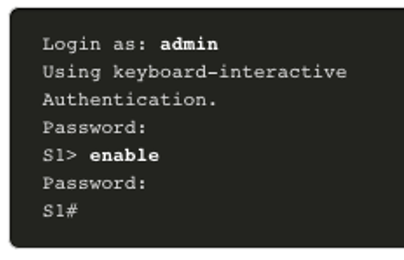1.3 Secure Remote Access
Telnet Operation
Telnet uses TCP port 23. It is an older protocol that uses unsecure plaintext transmission of both the login authentication (username and password) and the data transmitted between the communicating devices. A threat actor can monitor packets using Wireshark. For example, in the figure the threat actor captured the username admin and password ccna from a Telnet session. 
SSH Operation
Secure Shell (SSH) is a secure protocol that uses TCP port 22. It provides a secure (encrypted) management connection to a remote device. SSH should replace Telnet for management connections. SSH provides security for remote connections by providing strong encryption when a device is authenticated (username and password) and also for the transmitted data between the communicating devices. The figure shows a Wireshark capture of an SSH session. The threat actor can track the session using the IP address of the administrator device. However, unlike Telnet, with SSH the username and password are encrypted.
Verify the Switch Supports SSH
To enable SSH on a Catalyst 2960 switch, the switch must be using a version of the IOS software including cryptographic (encrypted) features and capabilities. Use the show version command on the switch to see which IOS the switch is currently running. An IOS filename that includes the combination “k9” supports cryptographic (encrypted) features and capabilities. The example shows the output of the show version command. 
Configure SSH
Before configuring SSH, the switch must be minimally configured with a unique hostname and the correct network connectivity settings.
- Step 1: Verify SSH support – Use the show ip ssh command to verify that the switch supports SSH. If the switch is not running an IOS that supports cryptographic features, this command is unrecognized.
- Step 2: Configure the IP domain – Configure the IP domain name of the network using the ip domain-name domain-name global configuration mode command.
- Step 3: Generate RSA key pairs – Generating an RSA key pair automatically enables SSH. Use the crypto key generate rsa global configuration mode command to enable the SSH server on the switch and generate an RSA key pair. Note: To delete the RSA key pair, use the crypto key zeroize rsa global configuration mode command. After the RSA key pair is deleted, the SSH server is automatically disabled.
- Step 4: Configure user authentication – The SSH server can authenticate users locally or using an authentication server. To use the local authentication method, create a username and password pair using the username username secret password global configuration mode command.
- Step 5: Configure the vty lines – Enable the SSH protocol on the vty lines by using the transport input ssh line configuration mode command. Use the line vty global configuration mode command and then the login local line configuration mode command to require local authentication for SSH connections from the local username database.
- Step 6: Enable SSH version 2 – By default, SSH supports both versions 1 and 2. When supporting both versions, this is shown in the show ip ssh output as supporting version 2. Enable SSH version using the ip ssh version 2 global configuration command.
Verify SSH is Operational
On a PC, an SSH client such as PuTTY, is used to connect to an SSH server. For example, assume the following is configured:
- SSH is enabled on switch S1
- Interface VLAN 99 (SVI) with IPv4 address 172.17.99.11 on switch S1
- PC1 with IPv4 address 172.17.99.21
Using a terminal emulator, initiate an SSH connection to the SVI VLAN IPv4 address of S1 from PC1. When connected, the user is prompted for a username and password as shown in the example. Using the configuration from the previous example, the username admin and password ccna are entered. After entering the correct combination, the user is connected via SSH to the command line interface (CLI) on the Catalyst 2960 switch.  To display the version and configuration data for SSH on the device that you configured as an SSH server, use the show ip ssh command. In the example, SSH version 2 is enabled.
To display the version and configuration data for SSH on the device that you configured as an SSH server, use the show ip ssh command. In the example, SSH version 2 is enabled. 
Other related topics
| Topic Title | Topic Objective |
|---|---|
| Configure a Switch with Initial Settings | Configure initial settings on a Cisco switch. |
| Configure Switch Ports | Configure switch ports to meet network requirements. |
| Secure Remote Access | Configure secure management access on a switch. |
| Basic Router Configuration | Configure basic settings on a router to route between two directly-connected networks, using CLI. |
| Verify Directly Connected Networks | Verify connectivity between two networks that are directly connected to a router. |
Other useful information
- Full CCNA Course
- CCNA Certificate Information
- 200-301 CCNA Exam Questions and Solutions
- 200-301 CCNA Exam Topics